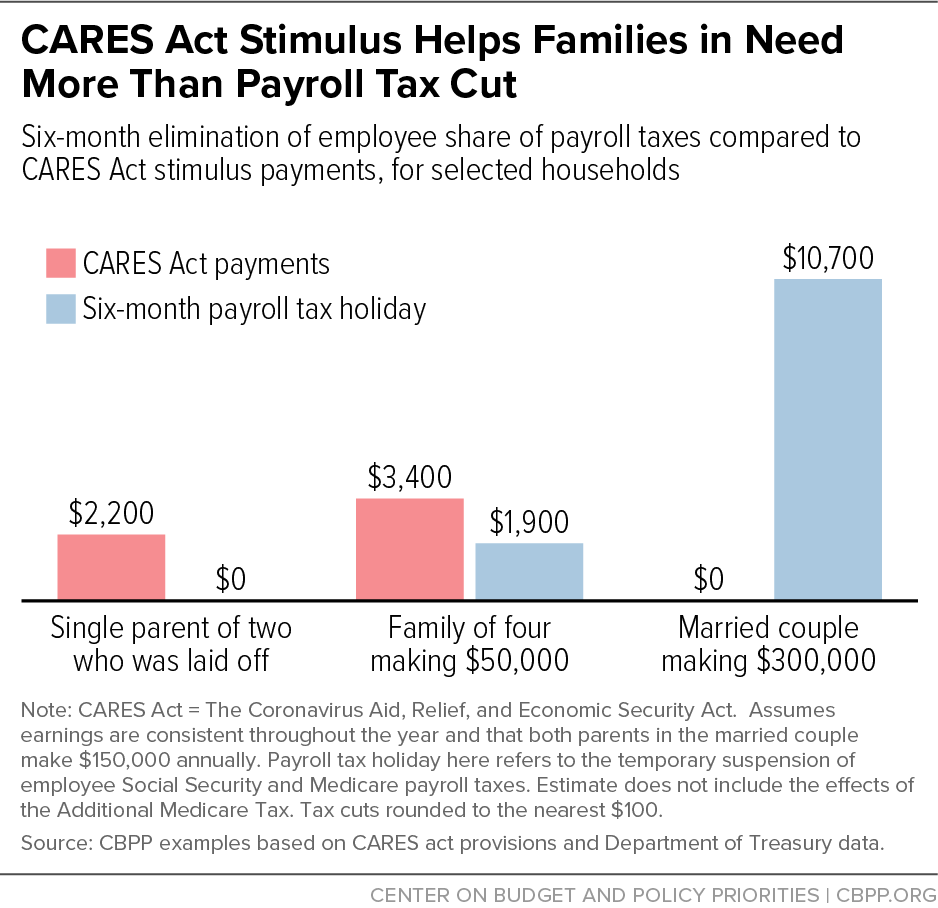President Trump has said he will not support any additional relief or stimulus measures in response to the human and economic crisis caused by the COVID-19 pandemic[1] unless they include a temporary payroll tax cut.[2] The Administration has yet to settle on a specific proposal, but Administration officials and advisors have floated several variations, including a temporary elimination of both the employer and employee share of payroll taxes. Payroll taxes amount to 15.3 percent of the first $137,700 of an individual’s earnings, with 7.65 percent paid by employees (withheld from paychecks) and 7.65 percent paid by the employer.[3]
Relief measures are most effective as economic stimulus if they quickly deliver resources to people and businesses that most need it and so are most likely to spend rather than save any extra dollars they receive, thereby shoring up consumer demand and reducing the recession’s depth and length. But a payroll tax cut scores poorly on these fronts.
- Cutting the employee share of payroll taxes gives the most help (in dollar terms) to higher earners, who are less likely to need the help or to spend most or all of the extra money. Compounding the weaknesses of this approach, it does less for those with lower earnings and nothing at all for people who have lost jobs.
- And cutting employer payroll taxes is an ineffective way to shore up business hiring and investment. Business’ main problem now is lack of customers for their products — both because of social distancing measures and because many customers’ incomes have fallen dramatically as unemployment has risen. Businesses will not hire (or retain) more workers or invest in more equipment than they need to produce the goods and services they can actually sell.
For these reasons, a payroll tax cut would constitute poor and inefficient economic stimulus. Other stimulus measures that would be highly effective and for which there is great need — such as aid to help states cover their $650 billion in revenue shortfalls and avoid deep cuts to state services,[4] strengthened nutrition assistance,[5] extended unemployment insurance, and measures to maintain and bolster health coverage and care — should not be held hostage to a poorly conceived payroll tax cut proposal.
Relief and stimulus for households is most effective if it gets rapidly to those who will spend it quickly — that is, low- and middle-income households, who must spend all or nearly all of their limited incomes to meet basic needs. A payroll tax cut does not achieve these aims well:
- People without earnings or jobs wouldn’t benefit at all — a particular drawback now, with tens of millions of people having recently lost employment. More than 32 million people have applied for unemployment insurance since claims began surging in March, with the most recent jobs report showing 20.5 million job losses in April and an unemployment rate of 14.7 percent. The Congressional Budget Office (CBO) projects that the unemployment rate will average 10.1 percent over 2021 and still be at 9.5 percent at the end of 2021.[6] That would be the highest annual average unemployment rate since the Great Depression. A payroll tax cut would do nothing for the millions of people who have lost jobs, even though they are among those likeliest to need help and to spend any added resources they receive. Nor would it help people who cannot work because they are sick or caring for family members, such as young children or family members who are ill or have disabilities, or who are seniors or people with disabilities themselves.
- People with higher earnings would receive more in dollar terms. Consider a six-month suspension of the employer and employee portions of the payroll tax. A couple earning a combined $275,400 (with each spouse earning the maximum earnings subject to full payroll taxes) would receive $10,534 in tax cuts over six months, while a single parent earning $20,000 as an essential worker cleaning hospital rooms would receive just $765. Even if the tax cut’s dollar value were capped, only higher earners would get the maximum benefit. Affluent households are less likely to require relief from financial hardship, and they generally spend a much smaller share of any added income than lower-income households do.
Also note that the money from a payroll tax cut would trickle out slowly, likely diluting its modest stimulus effect still further. For example, a payroll tax suspension would have to last more than ten months before a full-time worker earning the federal minimum wage would receive $1,000 from it.
President Trump has suggested that a payroll tax cut is superior to stimulus payments like those in the CARES Act.[7] In fact, the opposite is true, as a comparison of the CARES Act payments with a six-month elimination of the employee share of payroll taxes (which Trump informal advisors Steve Forbes and Arthur Laffer have proposed) demonstrates.[8]
Unlike a payroll tax cut, the CARES Act stimulus payments of $1,200 per adult and $500 per child under 17 reach the lowest-income people, including those with no earnings, because there is no minimum earnings threshold or phase-in to receive the full amount. (See Figure 1.)[9] The poorest adults receive the same $1,200 as middle-class adults, and children living in deep poverty receive the same $500 as middle-class children. Further, the stimulus payments phase down (and eventually phase out) for households with higher incomes.
In addition to being much better targeted, the stimulus payments can deliver more relief far more quickly than a payroll tax cut. The IRS and Treasury Department have delivered more than 130 million CARES Act payments in less than a month since the law’s passage.[10]
The Trump Administration has previously suggested applying the payroll tax cut to the employer’s share of the payroll tax as well as the employee’s share.[11] Temporarily suspending employers’ payroll taxes is highly unlikely to raise workers’ wages because it is only for a short period of time. Wage rates usually take time to adjust to changes in costs, and do so primarily when the changes in costs will be ongoing rather than short-lived. As a result, this likely wouldn’t improve workers’ finances significantly or lead them to spend more on goods and services. [12] As CBO has written, suspending employers’ payroll taxes generally “is unlikely to alter wage rates by very much and so would not alter consumers’ resources very much.”[13] Instead, a payroll tax cut would put cash into the hands of businesses but would likely be poorly targeted stimulus, providing too little to businesses that are struggling to survive while giving windfalls to those that are doing well.
Much as with individuals, businesses must spend the payroll tax cut they receive for it to be effective stimulus; otherwise, the funds will sit in the company’s coffers or be passed to shareholders, who tend to be well-off and spend little of extra resources they receive. CBO explained that a business tax break, like suspending the employer share of payroll tax, in a recession “typically does not create an incentive for [businesses] to spend more on labor or to produce more, because production depends on the ability to sell output.” Firms will only spend on hiring (or retaining) workers or investing in equipment if they need to do so to produce goods and services they can sell — which is driven by the demand for their products.
In a weak economy, businesses might take advantage of temporarily lower labor costs due to a payroll tax cut to try to increase sales by cutting prices, CBO argued in the same assessment. But that strategy is unlikely to succeed in the current situation. When so many people have lost jobs and earnings and the outlook is so uncertain, consumers are unlikely to respond to small changes in the price of goods and services, particularly for non-necessities. And, while many businesses need an infusion of cash to remain viable until social distancing measures ease and consumer demand strengthens, a payroll tax cut is not well designed for that purpose.
For example, consider a restaurant that can’t fully reopen until social distancing measures ease. It will likely have furloughed or laid off waiters, cooks, and other staff, but may need cash to pay rent and other basic expenses needed to survive until it can rehire staff. A payroll tax cut now would do little or nothing to help that firm because it has little current payroll and little reason to bring back workers while it has no customers. The tax cut would not provide enough cash to allow the owner to meet other continuing costs or prepare for more stringent public health measures upon reopening. By contrast, a large office software company whose workers can telework and still has strong demand for its products and services would get a tax-cut windfall that it likely would pass on to shareholders or let sit in its coffers, doing little to shore up overall consumer demand.
And an employer-side payroll tax cut makes even less sense now given that the CARES Act defers payment of employers’ payroll taxes until 2021, so companies would see no immediate cash-flow benefit.[14]
Rather than pursuing a costly and ineffective payroll tax cut, policymakers should address immediate needs and problematic gaps in the earlier relief measures. For example, they should improve the CARES Act stimulus payments by including many immigrant families and dependents over age 16 whom the measure unwisely left out.[15] They also should enact high-impact relief and stimulus measures such as aid to help states cover their massive revenue shortfalls and avoid deep cuts to state services (which would deepen and prolong the recession),[16] strengthened nutrition assistance[17] and extended unemployment benefits, and measures to maintain and bolster health coverage and care, especially through Medicaid. Such measures would help keep the economy from sinking further and alleviate hardship. These measures should be designed to remain in place until unemployment is no longer high and the economy has significantly recovered.[18]
Payroll tax revenues flow to the Social Security and Medicare Hospital Insurance trust funds.a When policymakers enacted a temporary payroll tax cut during the Great Recession, they protected the trust funds by replenishing them with general revenues. (The reduction in payroll taxes still adds to the budget deficit, as is appropriate for fiscal stimulus during a recession.)
Nevertheless, some observers fear that temporarily suspending the Social Security payroll tax, even with a transfer of general revenues to make the trust funds whole, could fuel efforts to eliminate the tax permanently, as President Trump apparently favors.b Eliminating the payroll tax would sever the link between a worker’s contributions to Social Security and the benefits received, effectively ending Social Security’s status as an earned benefit. Without its dedicated revenues, Social Security would also no longer be self-financing; instead, it would rely entirely on general revenues and would have to compete with other programs for those resources. These changes, in turn, could increase pressure to cut Social Security benefits, as some policymakers have long proposed.


